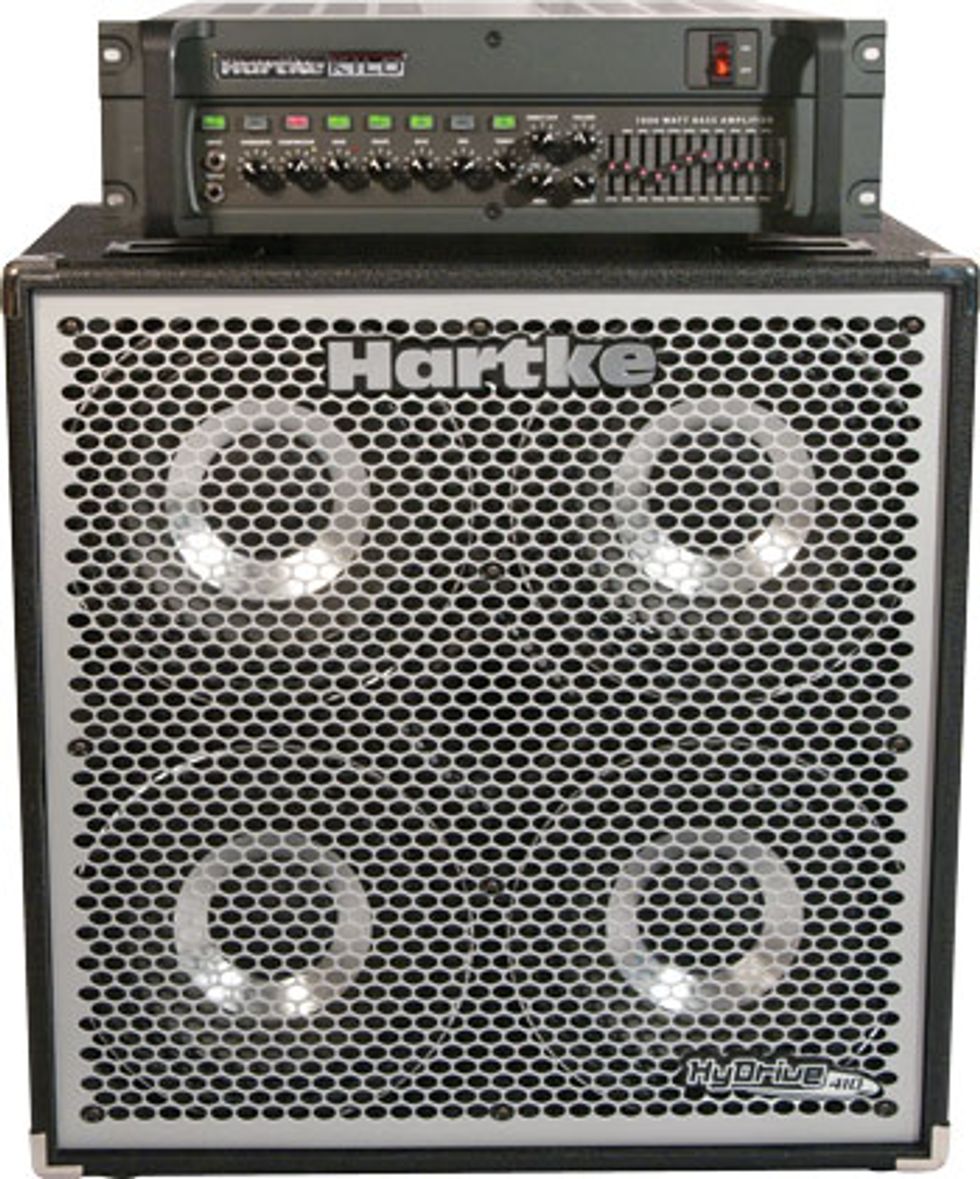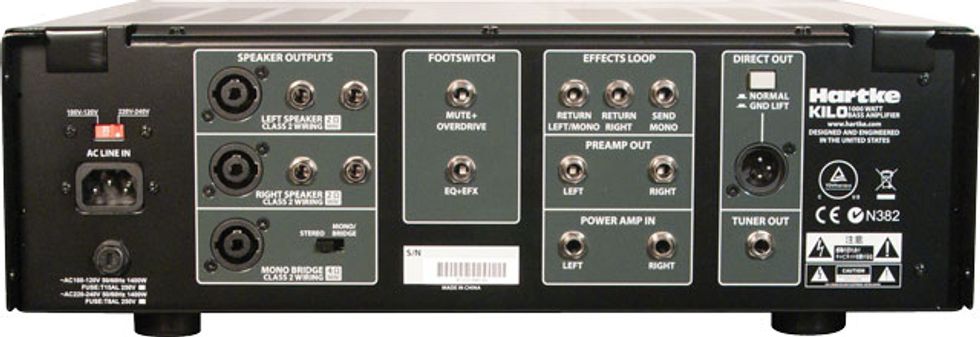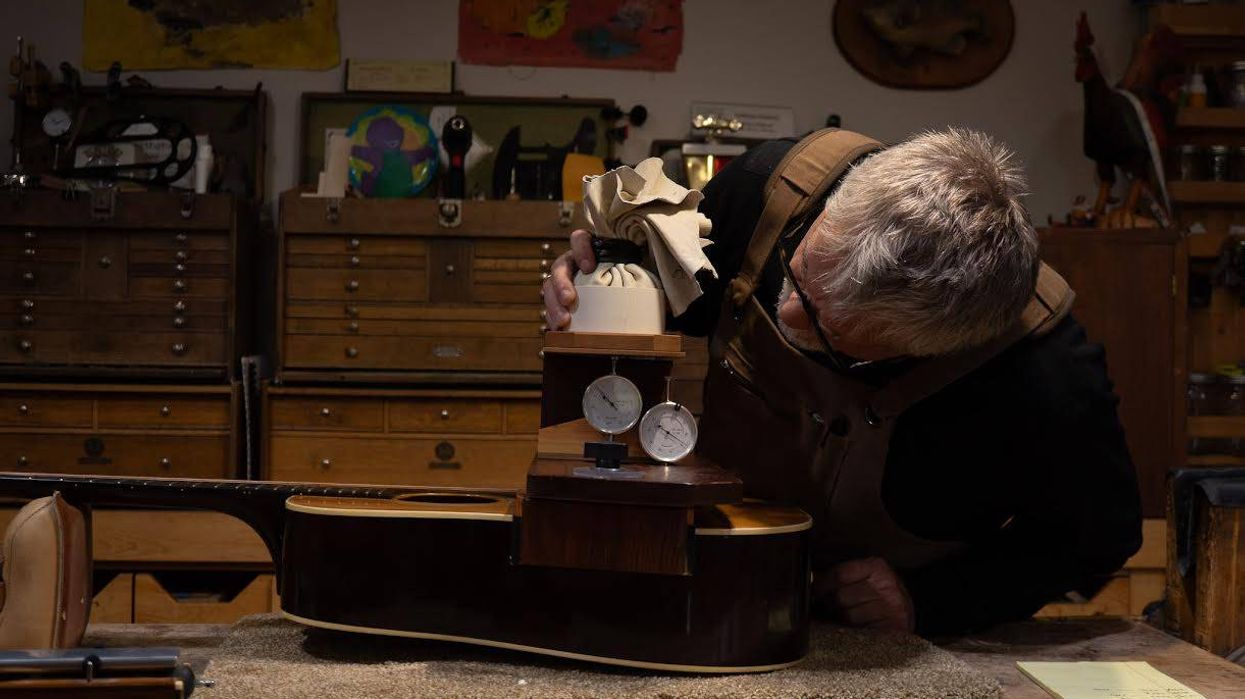
Compared to guitarists, it seems bassists often get the short end of the stick when it comes to the sheer numbers of gear offerings. Granted, the past decade has seen much more gear released for low-end rumble than ever before, but the numbers still pale in comparison to how many tone tools guitarists have at their disposal. This isn’t because bassists are afterthoughts to most companies—it’s mainly because the average bassist has fewer tone-palette needs than the average guitarist. For evidence, all you have to do is compare the number of bassists carting around gargantuan pedalboards and rack systems to the number of guitarists doing so.
However, a handful of effects and tone-processing circuits are integral to a significant number of discerning bassists, and Hartke—a bass-focused company that’s been serving some of the biggest names on the scene since the early ’80s—took pretty much all of those into consideration when designing their monstrously powerful new Kilo head. It features built-in compression, overdrive, muting, a slew of EQ controls, and multiple connection features.
Everything but the Kitchen Sink
The Kilo features an all-tube preamp driven
by a trio of 12AX7 tubes. After connecting
your bass to the amp’s input, your input
level is adjusted by a gain knob and a switch
that enables you to pad the input for active
pickups. Output is handled by a pair of solidstate
power amps, each running 500 watts at
2 Ω or a huge 1,000 watts at 4 Ω when in
bridged mono mode. In stereo mode, a balance
control varies volume between each side,
enabling you to have one cabinet louder than
the other if you wish. Tone shaping is handled
primarily by the tone-stack EQ’s bass,
midrange, and treble controls, but it can be
shaped further using a 10-band graphic EQ
with an independent volume control. If the
3- or 10-band EQs don’t offer enough range
for crafting your tone—and it would be
very surprising if they didn’t—the Kilo also
include three EQ-shaping push-buttons to
add 6 dB to the highs (brite), boost low end
(deep), and apply an adjustable EQ curve to
the entire tone (shape).
Overdrive can be brought in and out of the circuit via a front-panel button or a footswitch, and it ranges from light grit to super-heavy fuzz. Compression is one of the most essential effects for a wide swath of bassists, and the Kilo’s inclusion of such a circuit removes the need for a separate pedal or rack. Seems like a lot of features so far, huh? And this is only the front panel!
The back panel features three output sections—two for stereo mode or a single output for bridged-mono mode. The stereo section has two 1/4" jacks with a speakON output connector for each side of the stereo signal, all wired in parallel. The bridgedmono area has a single speakON connector, making it the only connection option to use when the amp’s power sections are combined. Dual outs for the preamp and dual ins for the power amp add to the Kilo’s versatility as a standalone tone generator that can be routed straight into a PA or a recording console. There’s also a second dedicated tuner output (the first is on the front panel), and an XLR out. Capping everything off is a pair of jacks for controlling the mute/ overdrive functions, as well as EQ and effects switching. There are also three 1/4" jacks for the stereo serial effects loop.

With Great Power Comes
Great Tone
To test the Kilo, I plugged in a Kramer USA
Striker bass and connected the head to two
Hartke HyDrive 410 cabinets, each of which
has four 250-watt, neodymium-hybrid-cone
speakers split between two sealed chambers.
Because the speakers are 40 percent lighter
than most 10" units, the cabs are surprisingly
lightweight and easy to carry.
Tonally, the Kilo is all about smoothness. Its power section serves up clean, booming bass, and the tube preamp keeps things from sounding too processed and flat. Even if you’re running it without any of the extra bells and whistles engaged, it excels at clear, powerful tone. With the 3-band EQ knobs at noon (and the graphic EQ switched off), the amp exhibited an impressively wide dynamic range but had plenty of room left on each control to modify the tone with more low end, scooped or humped mids, or high-end pop for slapping. The low end was thick and buttery smooth, the mids facilitated excellent articulation, and the highs were sweet and rich but never harsh. In short, I was able to coax a massive variety of tones out of the Kilo—from classic Motown grooves to slap-happy funk, dub-worthy tones, and percussive sounds that would fit in with the tightest of metal groups. In fact, even if the Kilo didn’t have all the other impressive accoutrements, the preamp alone would make it a compelling head. When you add in the graphic EQ, which has +/- 12 dB for each band, you’ve got an even more precisely seasoned and tasty smorgasbord of tones.
Beyond EQ curves, one of the Kilo’s most drastic and fantastic ways to modify your low end is its overdrive circuit—which is capable of adding a considerable amount of burly hairiness. With gain set around 11 o’clock, I conjured moderate grind by hitting the strings hard, but the sound still cleaned up when I backed off my attack. Things got warm and fuzzy as gain approached 3 o’clock, though the effect wasn’t quite as punchy as, say, an Electro- Harmonix Big Muff. However, it was easy to control the amount of grit without getting excessive feedback or having to cut bass frequencies or overbearing mids.
The Verdict
The Hartke Kilo is versatile enough to satisfy
just about any bassist. Though its range
of features may initially appear daunting to
players who prefer simple rigs, it’s so easy
and intuitive to use that even these players
owe it to themselves to check out its fantastically
punchy and diverse tones—because
it cranks out enough volume to cover pretty
much any style of music imaginable.
Kilo Rating:
Buy if...
burly yet infinitely tweakable tones are your bag.Skip if...
you don’t need massive wattage or you get option anxiety easily.Rating...
HyDrive 410 Rating:
Buy if...
your back twinges at the mere thought of traditional 4x10 cabs.Skip if...
you need the sub frequencies that only 12s or 15s can provide.Rating...







![Rig Rundown: AFI [2025]](https://www.premierguitar.com/media-library/youtube.jpg?id=62064741&width=1245&height=700&quality=70&coordinates=0%2C0%2C0%2C0)












 Shop Scott's Rig
Shop Scott's Rig















































